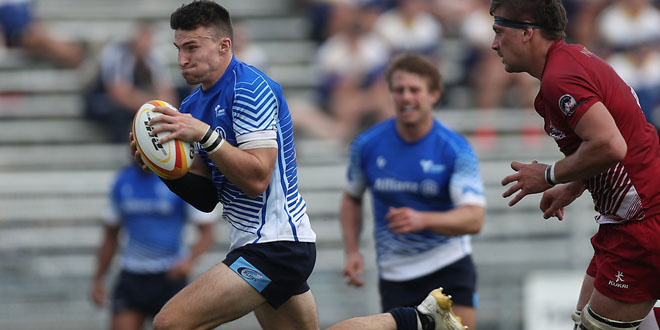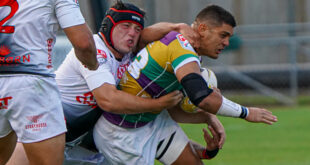Once again the Canadian Rugby Championship has come and gone in the blink of an eye. It’s a frustrating thing to see the supposed flagship domestic competition amount to so little year after year. If the rugby gods oblige Canada’s efforts for World Cup qualification perhaps then some focus will return to addressing the domestic pathway that needs an almighty overhaul.
Politics aside, the players themselves should be applauded for fronting up in dreadful conditions. Not only were they asked to play two full-on matches in four days but they also did it in exhausting heat with smoke-filled lungs thanks to the noxious air drifting east from the BC wildfires.
The injection of several internationals added intrigue but of concern was the number of individuals asked to play out of position. Most evident was the shortage of quality in the tight five. The Bears and Blues persisted with loosehead props playing tighthead and loose forwards frequented the second row.
In choosing a select XV from the group, players had to have started at least two matches to be considered. Greater weight was given to consistency over a stretch of games rather than a one-off performance. In most cases the top performers were self-evident with a number of quality flankers providing the greatest area for debate.
Predictably it’s the two finalists – the Ontario Blues and the Atlantic Rock – who provide the majority of the side. They share six spots each with the Rock forwards the best in show and the Blues setting the standards in the backs.
1 – Alex Forrest (Atlantic Rock) Forced to wait his turn behind Frank Walsh for the first two matches of the competition, the PEI native made up for lost time with two massive performances in Calgary that had capped internationals Ryan Kotlewski and Rob Brouwer going backwards at a rate of knots. He’s not just a scrummager, he’s also deceivingly mobile and very adept at getting over the ball at the breakdown. Still young in prop years, his next stop could be with the Arrows who he has already appeared for twice.
2 – Steven Ng (BC Bears) It was tempting to go for the entire Rock front row with Martial Lagain leading by example, but Ng caught the eye with his accuracy and his work ethic. Canada are not blessed with hordes of options at hooker so it’s pleasing to see a 20-year-old putting up his hand. His lineout throwing was a big step up from what he have seen from him previously and his leg drive in contact earned him three tries in four games. He played all 160 minutes for the Bears in Calgary, an indication of his value to the team. Eric Howard also went well albeit in a bench role for the Blues.
3 – Cole Keith (Atlantic Rock) Just 21 but already a veteran of 9 internationals. He remains a work in progress but has raw strength and aggression, two things strangely lacking in Canadian rugby at the moment. Admittedly the competition was thin. Had Tom Dolezel not missed out on Calgary or Doug Wooldridge played a more significant role there might have been cause for debate. As it was there was none required.
4 – Paul Ciulini (Ontario Blues) Second rows with the necessary bulk to play test rugby were in short supply during the CRC. Riley Fahlman had his moments for the Wolf Pack but not enough of them. The venerable Brad Lester soldiered on for the Rock and provided much-needed ballast in their scrum. Ciulini wasn’t spectacular but he is starting to look like the enforcer we thought he might be a couple years ago. He played all 80 minutes in three matches, including both matches in the smokey Calgary air. For a heavyweight tighthead lock that is commendable.
5 – Liam Carter (Atlantic Rock) A second PEI man cracks our team as our left lock and primary lineout target. Carter was an unsung hero for the Rock, his mobility and handling skills proving invaluable both as a ball carrier and on opposition throw-ins. This should come as no real surprise given he is really a loose forward, shunted into lock on account of the Rock’s riches in the back row. Mike Sheppard showed up well for the Canada Selects in France but didn’t have enough input for the Blues.
6 – Marcello Wainwright (Ontario Blues) The least recognized member of the Blues back row is an underrated player. His build is that of an openside but he is most often found on the blindside with his hard-hitting defensive style and straight-ahead running. Perhaps a student of the Serge Betsen school of blindside play, seek and destroy being the mantra. Wainwright scored twice in the tournament including a key try in the MacTier Cup final. Kyle Baillie would have been given greater consideration but his game time for the Rock was restricted and he spent the majority of that time playing at No8.
7 – Matt Heaton (Atlantic Rock) The best flanker in the competition and a contender for player of the tournament. His tireless pursuit of the ball saw him involved in almost everything. He hasn’t been a primary ball carrier at test level but had some notable incisions over the past month. Defensively he was rock solid and proved a more than useful option at the lineout. Ollie Nott went well for the Bears and Moe Abdelmonem impressed for the Rock though playing more on the blindside. James O’Neill’s performance in Week 1 was arguably the best individual effort of anyone all tournament before he was whisked away to lead the u20s in Romania.
8 – Grant Crowell (Prairie Wolf Pack) If the CRC is a vehicle for national selection no player put their hand up more so than the Wolf Pack dynamo. The best ball carrier in the competition by a distance, he scored in every game and finished as the tournament’s top try scorer with five in four matches. He was also the best restart winner on both sides of the ball. He is still a bit rough around the edges but it would be disappointing if he wasn’t rewarded with a trip to Montevideo.
9 – Andrew Ferguson (Ontario Blues) Once again showed himself the best scrumhalf in the competition. Creates space by challenging the fringe defense and finding green with well-placed kicks over the top. Third in the competition in scoring despite missing one game on national duty, his goal kicking let him down slightly at times but when you’re creating tries for others it doesn’t matter much. Also catching the eye was Rock instigator Graham Barry who took his chances in Calgary and went toe-to-toe with Ferguson in the final.
10 – Shawn Windsor (Ontario Blues) Not at his best throughout but good enough to lift yet another MacTier Cup. Has a tendency to stand a little deeper than some might prefer but his willingness to take on the line sets him apart from all other contenders. In the final his tactical kicking dictated where the game was played. Still can’t seem to get a crack at senior international honors despite consistently making the grade at the highest levels of domestic rugby.
11 – Kainoa Lloyd (Ontario Blues) Bar none the best finisher on display. There is an air of excitement every time he touches the ball. Very rarely fails to beat the first defender either with footwork or upper body strength. His four tries were good for second best behind Crowell and he only played three games. Handling and kicking remain work-ons but he is professional grade when it comes to breaking tackles.
12 – Jordan Wilson-Ross (Atlantic Rock) Looking slim and trim after a near two-year hiatus, the former Blues star was also playing in a new position at inside centre. He played the role of a traditional attacker and used his footwork to break the line on numerous occasions. Remains an impressive athlete but there is still a question of his best fit in the backline. Nick Blevins would have had a say had he not been injured in the opening week while the line-busting talents of his Wolf Pack teammate Mozac Samson were utterly wasted on the wing.
13 – Andrew Coe (Ontario Blues) One might point at his impressive showing as evidence that the return of some sevens players to 15-a-side contention has paid immediate dividends. That may be so in his case, but many would argue he should have been playing the full version all along. Playing at outside centre rather than his usual fullback spot, Coe’s eye for the gap and angled running was a nightmare for opposition in the two games he played. He doesn’t quite have the bulk yet to play in the midfield at test level but he showed the idea might have some legs down the road.
14 – Sean Ferguson (BC Bears) Split his time between wing and fullback. With Jake Bentley strangely benched by the Wolf Pack and others showing only flashes, it’s on the wing where we’ll draft the classy Ravens utility back. At 28 he is now a seasoned veteran in the CRC and just seems to always be in the right place at the right time. Ferguson’s four tries were good for second-most in the competition and secure his place as one of the standout attacking players.
15 – Cooper Coats (Atlantic Rock) Another new name who will have impressed the selectors though perhaps not quite as emphatically as Crowell. Playing fullback for three matches and his natural flyhalf position in one, Coats showed off his vision and exceptional kicking skills. Despite finishing as the tournament’s top scorer he won’t be pleased with his himself after missing two penalties against the Blues. Don’t be surprised to see him wearing a blue and gold Arrows jersey again this fall.
 Americas Rugby News Rugby news from across the Americas!
Americas Rugby News Rugby news from across the Americas!




